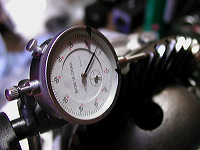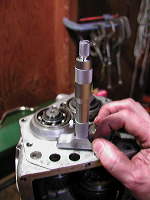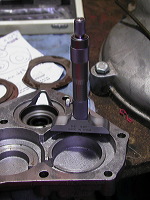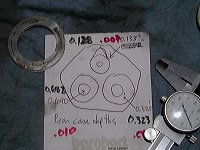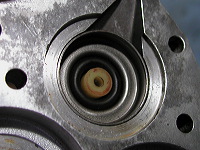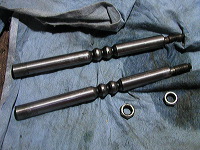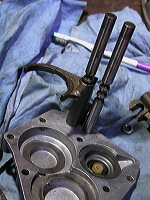The cover is more than just a covering. Its other job is to provide the correct amount of pressure on the ball bearings that support the gearshafts. These bearings need to be pressed with the correct amount of force to keep them running smoothly and quietly.
This pressure is provided by ring-shaped shims that fit between the bearings and the rear cover. The goal here is to choose the right thickness for the shims, so that they press with the correct amount of force when the rear-cover bolts are tightened to the correct torque.
The first step to choosing the shim thickness is to calculate the clearance between the back wall of the gearbox and the rear cover. Here, I'm measuring the shoulder height of the rear wall with a depth micrometer.
According to the manual, this clearance needs to include the thickness of a gasket, nominally about .006 inch. But again, Jack Lawrence gave me different advice. He suggests omitting the gasket and instead choosing shims that will allow only .002 inch gap between the case and the rear cover. He recommends using non-high-temp Dow Corning silicone sealer to seal the cover to the case, instead of the gasket.
Why no gasket? Lawrence explains it this way: if you use a gasket and it fails, you've got a gap .006 inch thick by the length of the break. This is a good-size hole, through which gear lubricant could leak out quickly. If it should leak out before you noticed it, you could ruin the gearbox.
Omitting the gasket and setting the clearance to .002 inch makes for a much thinner gap in case of a break. That gap will leak much more slowly, giving you more chance to notice it. And, Lawrence said, simply retightening the rear-cover bolts may be enough to seal up the leak.
Watch out for this rubber ring and nylon plug! They're easy to lose and very important. They help guide lubricant, caught in the slot above them, into a hole that lubricates the gear shaft.
